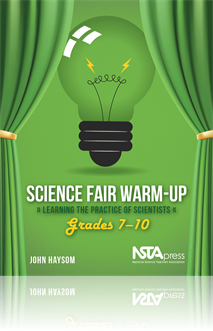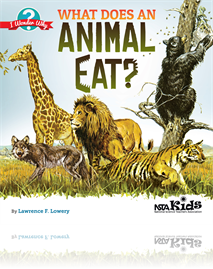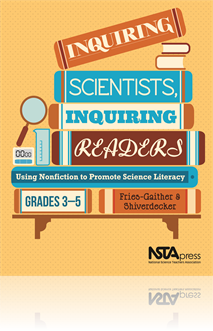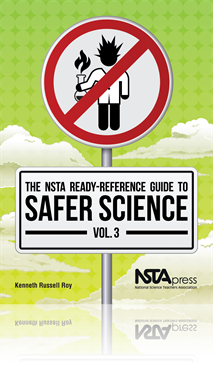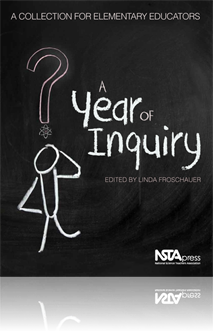All Book Chapters
Book Chapter
It’s not easy to tell what science fairs and science projects are all about. The best way to find out is to do a project and take it to a science fair. This chapter provides “starting points” for projects and these “starting points” have be...
Book Chapter
An Overview of the Nature of Scientific Inquiry: What Do Scientists Do?
This chapter explores the question, “What do scientists do?” A good way to find out what scientists do is to try being a scientist. The chapter presents a challenge to students with an exercise on falling objects. It isn’t easy to make sense of...
Book Chapter
Science Without Numbers: Looking for Similarities and Differences
This chapter presents the task of students finding out all they can about the soil by looking for similarities and differences. This task allows students to experience a little of the difficulty and puzzlement the early chemists faced centuries ago a...
Book Chapter
Variables and Their Controls: Finding Out How Much It Matters
In this chapter, students are asked to be a ramp design consultant and to devise a test rig using a toy racetrack and a ball. They need to determine the best angle for the ramp and think about what makes a fair test. The angle could be difficult to ...
Book Chapter
Experiment Design: Designing Good Apparatus
This chapter presents the task of judging bubble solutions to see which makes the biggest bubbles and the longest-lasting bubbles. Students design and carry out a scientific experiment to decide which bubble solution is better. This is a real challe...
Book Chapter
Sources of Error: Searching for Errors
This chapter investigates suffocating candles and how long a candle stays lit in jars of different sizes. The students’ task is to try to find out what the uncontrolled variable is and how to control the variable, while using their knowledge and ex...
Book Chapter
Making Sense of Your Results: Graphing Your Data
This chapter features two projects—one on the science of table tennis and one on exploring the best way to stop needles from falling off Christmas trees. The focus is on “graphing the data,” and the decisions that need to be made, such as bar ...
Book Chapter
Explanations: Getting Explanations That Fit
This chapter deals with “getting explanations that fit.” When scientists do experiments, they try to explain their findings by connecting the results to what they already know. When they encounter a new happening—or phenomena—they try to fit ...
Book Chapter
Sharing Your Findings: Writing Your Report
After scientists have done an experiment or a series of experiments, they usually take time to write their reports. This not only gives them a chance to get their thinking together but also—and even more important—enables them to share their wor...
Book Chapter
Judging Projects: Suggesting Improvements
This chapter focuses on “suggesting improvements.” When a scientist sends a report of an investigation to a journal for publication, the editor consults experts on whether the investigation was done well and if the findings are valuable. The expe...
Book Chapter
Generating Ideas for Projects: Ideas All Around You
Some of the best science fair projects can be found right in the world around you. These projects are found when you start looking at cooking, gardening, and TV commercials from a scientist’s perspective. The best way for brainstorming ideas is to...
Book Chapter
Science fair projects are about real problems that you choose to explore. The problems are challenging and fun. The best way to find out what science fair projects are all about is to do a project and take it to a science fair. This chapter provides ...
Book Chapter
The wing of a bat, the bone in your leg, the stem of a plant—all have elegant, elaborate structures. Scientists would like to understand how and why these structures developed and engineers are also concerned with developing an understanding of str...
Book Chapter
Science Without Numbers: Searching for Patterns
Searching for patterns is often the very beginning of sense making. We do it all the time. Scientists try to find patterns in their observations, then understand how these patterns are connected. For example, the way you go about cracking a code is s...
Book Chapter
The Numbers Game: Designing Your Own Measures
Have you ever wondered how people managed before the ruler and the clock were invented? Today, scientists use the metric system of measurement—one based on the meter, kilogram, and second. It is a decimal system. To measure length, normally a ruler...
Book Chapter
Experiment Design: Preparing Experimental Designs
This chapter focuses on turning cooking into a science. A cookie recipe is shared with students along with a list of questions to consider. Students are also invited to develop the recipe. If scientists were given a recipe to develop, they would t...
Book Chapter
Sources of Error: Sampling: An Introduction
Sampling is a technical matter—it has to be planned carefully. The accuracy and reliability of the results are calculated using statistics. For example, the connection between high salt consumption and high blood pressure was established using stat...
Book Chapter
Making Sense of Your Results: Interpreting Graphs
Graphs can tell a story and are like a silent interpreter. They give meaning to numbers and turn numbers into pictures, but words still need to be input. This chapter presents the case of the bean seed planted in a glass jar so that growth is visible...
Book Chapter
Explanations: Deepening Your Understanding: Analogies and Models
This chapter highlights the project—“The Right Nail for the Right Job”—and extends the understanding of the behavior of wood and nails. Scientists often use analogies to extend their understanding. Analogies help to “see” things in an ext...
Book Chapter
Sharing Your Findings: Talking About Your Project
After finishing investigations or experiments, scientists frequently present their findings at a conference. If their presentations are well received, scientists are then encouraged to send the papers to scientific journals for publication so they ca...
Book Chapter
Judging Projects: Making Judgments
Scientists often put themselves in other scientists’ shoes to make judgments by saying “if I had been doing that piece of research, what would I have done?” Making judgments involves making such comparisons. In this way, scientists learn from o...
Book Chapter
Generating Ideas for Projects: Ideas From the Scientific Literature
Scientists keep in touch with one another by writing about their experiments in journals. These are the original sources of information that spread quickly to others through science magazines, newspaper reports, and television programs. Information i...
Book Chapter
Plant Biomass (Photosynthesis)
The purpose of this activity is to help students understand the synthesis and source of plant biomass, as well as the process of photosynthesis. This activity also helps students learn how to engage in practices such as using planning and carrying ou...
Book Chapter
This sample from, What Does an Animal Eat? offers insights into two special aspects of hungry animals: how their teeth and beaks offer clues about what they eat and how the food chain helps make sure there’s enough for all. ...
Book Chapter
The Science-Literacy Connection
There has been much talk about integrating science and literacy instruction in recent years. Why this focus, particularly in the elementary classroom? One very practical reason is to make time in a crowded curriculum. Teachers are confronted with the...
Book Chapter
In this chapter, the class works to answer the question, What are the characteristics of trees? Each group of students in the class selects a type of tree to investigate, such as oak, ash, or maple, and then answers the subquestion, “What are the c...
Book Chapter
In this chapter, students work to answer the question, How does the shape of a bird’s wing affect its flight? Students first investigate how factors such as wing length and shape affect the takeoff and flight of a paper airplane. They use this info...
Book Chapter
Drip Drop Detectives: Exposing The Water Cycle
Throughout the inquiry, in this chapter, students play the role of scientists who are investigating the question, How can a drop of water travel around the world? Students examine the water cycle: evaporation, condensation, infiltration, and transpir...
Book Chapter
This chapter invites students to assume the role of paleontologists in a simulated dig in order to answer the question, What can we learn from studying fossils? Correspondence with a mysterious (fictional) paleontologist and the reading of informatio...
Book Chapter
Inquiry And The Learning Cycle
Inquiry instruction combines the teaching of scientific content with the development of scientific practices. Inquiry-based instruction has five essential features that occur along an inquiry continuum. In this chapter, the authors review the five fe...
Book Chapter
Authentic And Relevant Literacy Experiences In Inquiry
In this chapter, the authors explain the layout of the units in the book. The authors integrated inquiry and literacy in learning cycle units in authentic and relevant ways. Through these units students have opportunities to develop scientific conten...
Book Chapter
The rewards of creating nonfiction text sets are great for both teachers and students. Teachers the authors have worked with say that this approach has increased their understanding of nonfiction text and enhanced their awareness of the great diversi...
Book Chapter
Getting Started With The Inquiry Units
It is always exciting to try something new in your classroom, but we know it can also be challenging. Step one is, of course, to read the unit beginning to end. In the chapter, the authors provide some things to think about as you prepare to teach th...
Book Chapter
In this chapter, students work to answer two testable questions: Who can become a scientist? and What do scientists do? Students learn about the lives and work of eight scientists: John James Audubon, Charles William Beebe (known as William Beebe), R...
Book Chapter
Through the inquiry in this chapter, students work to answer the question, How does measurement help us know about the world? The focus of the inquiry is what measurement can tell us. A scavenger hunt helps students learn to use measurement to descri...
Book Chapter
Minds-On Matter: Phase Changes And Physical Properties
In this inquiry, students work to answer the question, How do the physical properties of a material change during phase changes? Students observe and measure physical properties of solids, liquids, and gases. They also measure the changes in temperat...
Book Chapter
Classroom Curling: Exploring Forces and Motion
Through the inquiry, in this chapter, students work to answer the question, What happens to the motion of a slider when different forces are applied? Teams of students play a game of “classroom curling”—a loose adaptation of the sport of curlin...
Book Chapter
Introduction to Safety in Science
This sample chapter provides an overview of general safety practices for the classroom. Topics discussed are Making Adjustments for Mobility- Impaired Students, Laboratory Safety: Welcome Aboard!, Good-Bye MSDS, Hello SDS! Yes, NSTA’s Portal Into t...
Book Chapter
Beaks And Biomes: Understanding Adaptation In Migrating Organisms
In this chapter students conduct direct and indirect investigations to answer the question, How is the sanderling adapted to survive in two different environments? The unit focuses on the sanderling, a shorebird that migrates from warm, sunny beaches...
Book Chapter
Inquiry Into the Heart of a Comet
Wouldn’t it be thrilling to emulate a real life model of science in action in classrooms? How? By starting with a great, hands-on activity modeling an object in space that introduces both key vocabulary and science concepts with visuals to support ...



